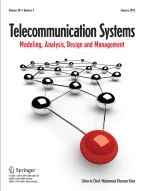Abstract
We propose in this paper a data-centric routing protocol for wireless sensor network applications. This protocol, called SABAGAR, is designed to be implemented easily to provide the basis for commercially successful products, and to await more vendors in wireless products. Sensor nodes may have no global identifications because the number of sensors can be large, hence, attribute-based addressing and broadcast communication paradigm can be used to facilitate data acquisition. However, broadcasting simply by flooding usually results in serious redundancy and endlessly looping packets, and thus degrades the network performance. To deal with this problem, we present a position-vector-based (PVB) algorithm for the SABAGAR protocol. This paper also provides detailed simulation results to support the proposed protocol design.
Similar content being viewed by others
Explore related subjects
Discover the latest articles, news and stories from top researchers in related subjects.References
F. Akyildiz, W. Su, Y. Sankarasubramaniam and E. Cayirci, A survey on sensor network, IEEE Communications40(8) (2002) 102–114.
Y.K. Dalal and R.M. Metcalfe, Reverse path forwarding of broadcast packets, Communications of the ACM 21(12) (1978) 1040–1048.
Z.J. Haas, J.Y. Halpern and L. Li, Gossip-based ad-hoc routing networks, in: Proc. of IEEE INFOCOM 2002, New York, 23–27 June, pp. 1707–1716.
W.R. Heinzelman, A. Chandrakasan and H. Balakrishnan, Energy-efficient communication protocol for wireless microsensor networks, in: Proc. of IEEE 33rd Internat. Conf. on System Sciences (HICSS' 00), 4–7 January 2000, Maui, Hawaii, pp. 3005–3014.
W. Heinzelman, A. Chandrakasan and H. Balakrishnan, An application-specific protocol architecture for wireless microsensor networks, IEEE Transactions onWireless Communications 1(4) (2002) 660–670.
C. Intanagonwiwat, R. Govindan and D. Estrin, Directed diffusion: A scalable and robust communication paradigm for sensor networks, in: Proc. of the 6th Annual Internat. Conf. on Mobile Computing and Networking (MobiCOM' 00), August 2000, Boston, MA, USA, pp. 56–67.
Y.-B. Ko and N.H. Vaidya, Location-aided routing (LAR) in mobile ad-hoc networks, in: Proc. of the 4th Annual ACM/IEEE Internat. Conf. on Mobile Computing and Networking (Mobicom' 98), Dallas, TX, USA, October 1998, pp. 66–75.
B. Krishanamachari, D. Estrin and S. Wicker, The impact of data aggregation in wireless sensor networks, in: Proc. of 22nd Internat. Conf. on Distributed Computing Systems Workshops (ICDCSW' 02), Vienna, Austria, 2–5 July2002, pp. 575–578.
Ns-2 network simulator, http://www-mash.cs.berkeley.edu/ns/ (1998).
C.E. Perkins, Ad-hoc Networking (Addison-Wesley, Reading, MA, 2001).
A. Qayyum, L. Viennot and A. Laouiti, Multipoint relaying for flooding broadcast messages in mobile wireless networks, in: Proc. of the 35th Annual Hawaii Internat. Conf. on System Sciences (HICSS-35 2002), Big Island, Hawaii, USA, 7–10 January 2002, pp. 3898–3907.
W. Rabiner, J. Kulik and H. Balakrishnan, Adaptive protocols for information dissemination in wireless sensor networks, in: Proc. of the 5th ACM/IEEE Mobicom Conference, Seattle,WA, August 1999, pp. 174–185.
Simjava, http://www.dcs.ed.ac.uk/home/hase/simjava/ (1997).
K. Sohrabi, J. Gao, V. Ailawadhi and G.J. Pottie, Protocols for self-organization of a wireless sensor network, IEEE Personal Communications 7(5) (2000) 16–27.
K. Sohrabi and G.J. Pottie, Performance of a novel self-organization protocol for wireless ad-hoc sensor networks, in: Proc. of IEEE VTS 50th Vehicular Technology Conference, Fall 1999 (VTC 1999), Vol. 2, Amsterdam, The Netherlands, pp. 1222–1226.
L. Subramanian and R.H. Katz, An architecture for building self-configurable systems, in: Proc. of IEEE/ACM1st Annual Workchop on Mobile and Ad-hoc Networks and Computing (MobiHOC 2000), Boston, August 2000, pp. 63–73.
S. Tilak, N. Abu-Ghazaleh and W. Heinzelman, A taxonomy of wireless micro-sensor network models, ACM Mobile Computing and Communications Review6(2) (2002) 28–36.
S. Tilak, N.B. Abu-Ghazaleh and W. Heinzelman, Infrastructure tradeoffs for sensor networks, in: Proc. of the ACM 1st Internat. Workshop on Sensor Networks and Applications (WSNA' 02), Westin Peachtree Plaza, Atlanta,GA, USA, 28 September 2002, pp. 49–58.
Y.-C. Tseng, S.-Y. Ni, Y.-S. Chen and J.-P. Sheu, The broadcast storm problem in a mobile ad-hoc network, ACM Wireless Networks 8(2) (2002) 153–167.
V. Tsiatsis, S.A. Zimbeck and M.B. Srivastava, Architecture strategies for energy-efficient packet forwarding in sensor networks, in: Proc. of the Internat. Symposium of Low Power Electronics and Devices (ISLPED), 6–7 August 2001, Huntigton Beach, CA, USA, pp. 92–95.
Author information
Authors and Affiliations
Rights and permissions
About this article
Cite this article
Wang, ST., Wu, JL.C. SABAGAR: A Simple Attribute-Based Addressing and GPS-Aided Routing Protocol for Applications in Wireless Sensor Networks. Telecommunication Systems 26, 197–212 (2004). https://doi.org/10.1023/B:TELS.0000029039.48019.64
Issue Date:
DOI: https://doi.org/10.1023/B:TELS.0000029039.48019.64


